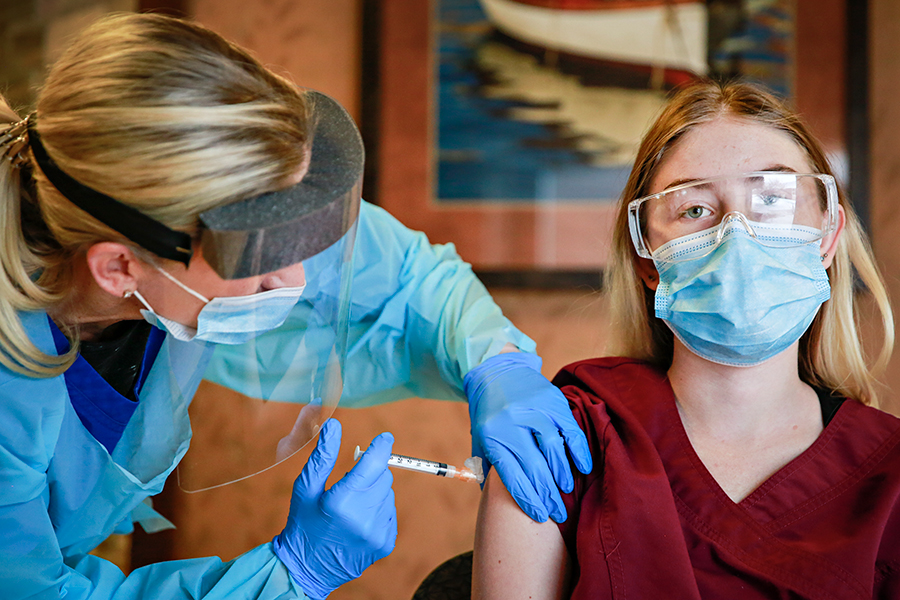Health Officials Ready for Next Phase of COVID Vaccine Deployment
All skilled nursing facilities in Montana are supposed to receive vaccine by Jan. 18; health department should begin more widespread vaccination next week
By Andy Viano
Flathead County residents identified in Phase 1b under the state’s revised COVID-19 immunization plan — including anyone at least 70 years old, American Indians and people of color, and those with high-risk medical conditions — could begin receiving their first vaccine doses as early as Jan. 19.
Health Officer Joe Russell said the Flathead City-County Health Department is expected to receive regular allotments of the COVID-19 vaccine beginning next week, when the county will start to tackle the challenge of immunizing as many as 25,000 Flathead County residents who fit into Phase 1b, according to Russell. The county could receive more than 1,000 doses next week, Russell estimated, with the state expected to distribute 13,000 doses on a weekly basis.
The state health department revised its vaccine distribution plan last week at the direction of newly installed Gov. Greg Gianforte, lowering the minimum age for immunization from 75 and including those most at risk for bad outcomes in Phase 1b, but pushing frontline essential workers, notably educators, further down the list. Gianforte also announced during his first week in office that he would keep the state’s mask mandate in place for the immediate future, at least until “we’re able to get this vaccine out to the most vulnerable.”
In all, Russell said the governor’s action (or inaction) was welcome, particularly lowering the minimum age and retaining the mask mandate, although he and others are planning to push the state to rethink the potential implications of making educators wait longer to receive the vaccine.
“My main goal in getting teachers vaccinated is the fact that if we’re thinking about business continuity, we don’t need people that are working in business (staying) home because we are closing the schools,” Russell said. “We have to be careful with our adults, our teachers, our staff. I think a lot of us felt it would have been nice to keep teachers up there.”
The current Phase 1b recipients are defined as those age 70 and older, American Indians and other people of color who may be at elevated risk for COVID-19 complications, and people age 16 to 69 with a qualifying high-risk medical condition, including: cancer, chronic kidney disease, chronic obstructive pulmonary disease, Down syndrome, heart conditions, a weakened immune system from a solid organ transplant, severe obesity, sickle cell disease and diabetes. Patients may also be eligible for the vaccine on a case-by-case basis if recommended by a medical provider.
Before Phase 1b doses will be administered, however, the county and state hope to be just about finished with Phase 1a. The first batch of vaccine was distributed in mid-December, with frontline healthcare workers, healthcare workers with direct patient contact, and residents of long-term care or assisted living facilities all eligible to be vaccinated. So far, most eligible recipients in Flathead County have been immunized, including scores of employees connected to Logan Health in Kalispell and at North Valley Hospital in Whitefish.
Russell called the uptake of the vaccine among doctors and nurses “very, very high,” although specific data was not available. State guidelines place any healthcare workers with direct patient contact in Phase 1a, including dentists, orthodontists, physical therapists, optometrists, home health workers and others. Flathead County has included law enforcement, firefighters and emergency responders in that group as well.
As of Jan. 8, the Montana Department of Public Health and Human Services (DPHHS) reported more than 33,000 vaccine doses had been administered to healthcare workers throughout the state, and that vaccination efforts had been initiated at 54 of the state’s long-term care facilities.
Things had run a little less smoothly for some of those long-term facilities, however, but as of Jan. 11 it appeared any issues in Flathead County would be ironed out before next week. The Centers for Disease Control and Prevention directed that long-term care facilities receive the vaccine solely from an eligible pharmacy (in Montana, either Walgreens, CVS or Big Sky Managed Care) leaving the county health department with no role in immunization, a federally mandated move that puzzled Russell and some employees of those facilities who were frustrated by the process.
At Immanuel Lutheran Communities in Kalispell, Chief Operating Officer Carla Wilton began communicating with CVS Pharmacy in early December and was told at the time that her facility could be holding a clinic by the end of the year. Instead, Wilton said, she heard nothing from the company until early January when she was told to expect the vaccine in mid-February or March. After pleading with the company and some political outreach, CVS pushed the date up and, last Friday, the facility was finally given Jan. 16 as the date of an immunization clinic at Immanuel Care Center and Jan. 23 at Buffalo Hill Terrace. Those dates align with the DPHHS targets for nursing homes (Jan. 18) and assisted living facilities (Jan. 24) to receive the first of the vaccine’s two doses.
For Wilton, the arrival of the vaccine will bring a welcome end to what she called “the most stressful 10 months of (her) career.”
“I’m proud, so proud of the team. It’s been a grind,” she said. “It feels like Groundhog’s Day and we’ve missed our families, we’ve missed them coming to visit and the reality is we miss them as much as they miss coming in, so it’s been hard on everybody.”
“We’re looking forward to the vaccine, it will be a big celebration. We’re ready.”